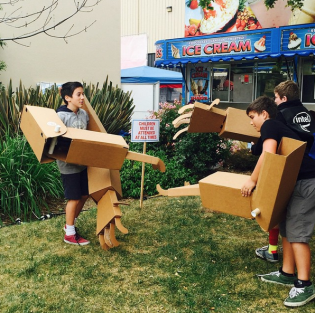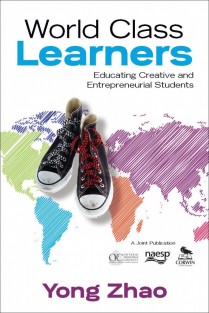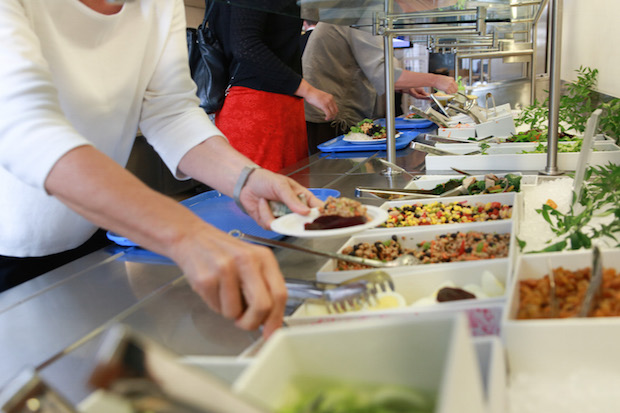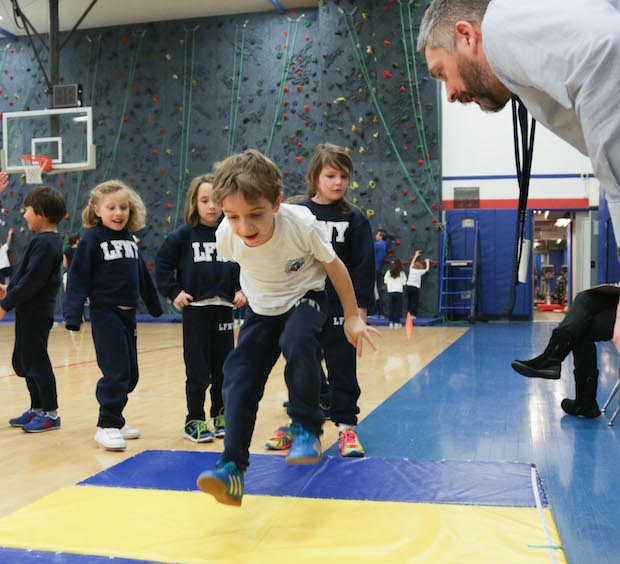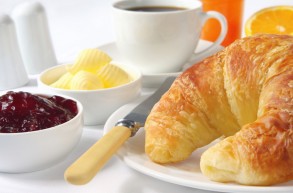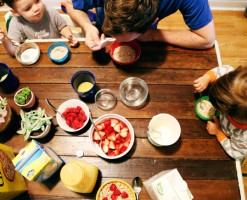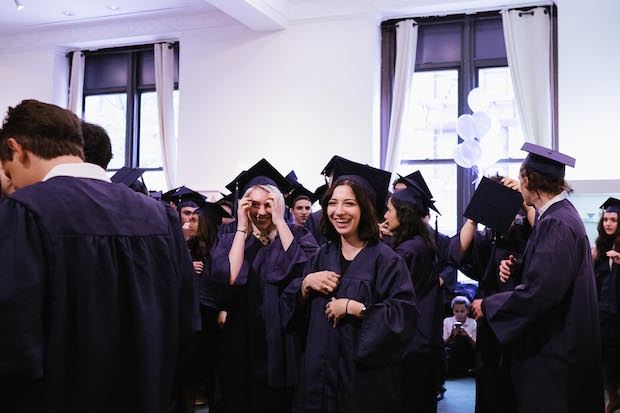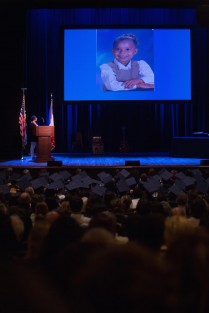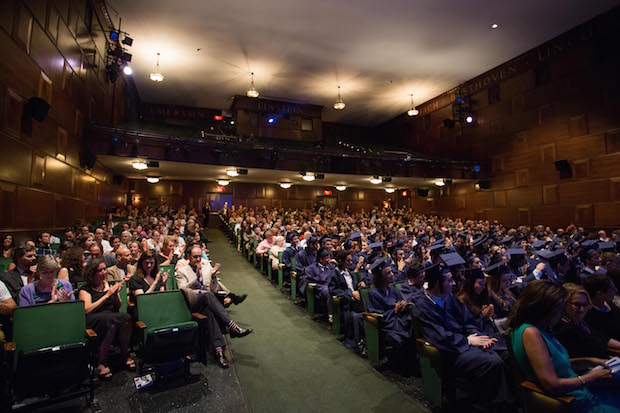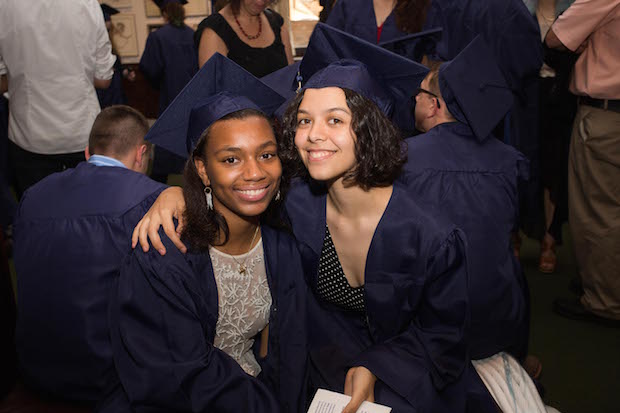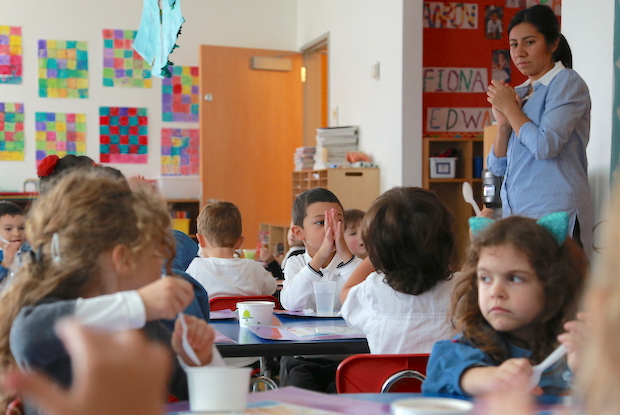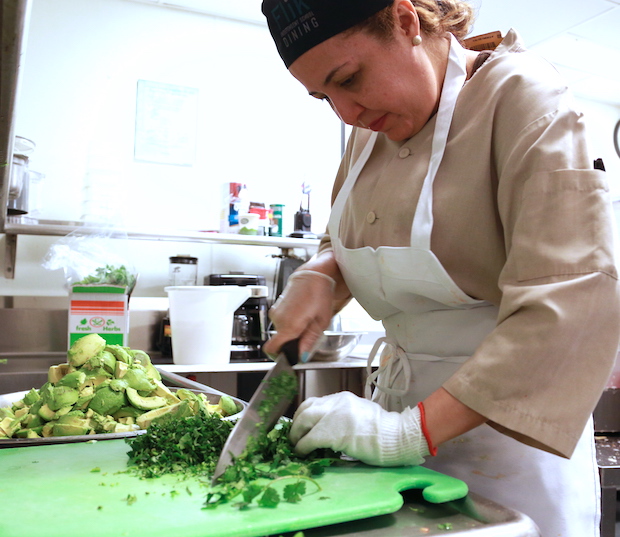Nous voici tous rentrés à l’école, les cartables remplis de cahiers neufs, de livres brillants et de bonnes résolutions. Après avoir surmonté les premiers jours d’adaptation, les nouveaux professeurs et le nouvel emploi du temps, certains reprennent aussi de… mauvaises habitudes : arriver au lycée pour une bonne journée de travail… mais le ventre vide ! Nous avons tous besoin d’un bon petit-déjeuner le matin : pourquoi ? que choisir pour le petit déjeuner ? et surtout comment faire pour réussir à faire petit-déjeuner un adolescent… récalcitrant !
Pourquoi est-il important de prendre un petit-déjeuner ?
Pour briser le jeûne : Au réveil, le corps est resté à jeun pendant de longues heures, souvent 11 à 12 heures ! Il est indispensable de faire le plein d’énergie !
Le petit déjeuner doit couvrir à lui seul un quart des besoins énergétiques dont le corps a besoin dans la journée… Il permet d’alimenter en énergie les muscles et le cerveau pour réaliser les tâches quotidiennes qu’elles soient physiques (respirer, marcher, courir) ou mentales (réfléchir, penser, apprendre). Passer un examen peut ainsi nous amener à brûler autant de calories qu’une séance de sport !
Pour éviter “ le coup de fatigue de 11h” : au lycée, il tombe plutôt vers 11h20 où chaque jour trois ou quatre étudiants se présentent persuadés d’avoir été victime d’un mal aussi inconnu que terrible se traduisant par des crampes d’estomac à les plier en quatre… oui, cela s’appelle la faim ! Maux de tête, fatigue intense et autres vertiges sont aussi légion. Un peu d’eau sucrée les ressucite et leur évite de manquer le test de maths… mais voilà, les capacités de concentration sont déjà durement touchées par ce déficit d’énergie et les performances intellectuelles, lors d’un test en l’occurrence, sont déjà plus chancelantes. Car le petit déjeuner est indispensable à une bonne concentration et donc participe pleinement à la réussite scolaire.
![untitled-34]()
Les enfants qui ne prennent pas de petit-déjeuner risquent de faire de l’hypoglycémie lorsqu’ils sont en cours de sport.
Pour éviter un malaise pendant les cours de sport : régulièrement viennent à l’infirmerie des élèves pâles et hors d’haleine, pris de vertiges et tout tremblants ; l’incompréhension de ce qui leur arrive les porte même au bord de la panique. Du repos, de l’eau, du sucre, un encas et beaucoup de réassurance leur permettent de retrouver leur état habituel. Dans la plupart des cas, sinon tous, ces élèves n’ont pas pris de petit-déjeuner (ou un petit-déjeuner très insuffisant) ce qui provoque une hypoglycémie. Les conséquences ? Ils sont désespérés d’avoir échoué leur test de sport, viennent de perdre une heure de cours pour s’en remettre et resteront fatigués tout le reste de la journée… Un prix fort pour avoir raté un des meilleurs repas de la journée !
Pour limiter les grignotages : cela a été prouvé et re-prouvé: ne pas prendre de petit-déjeuner pousse à grignoter dans la matinée, et à manger davantage au déjeuner avec une attirance marqué pour les produits gras et sucrés que notre cerveau reconnait comme plus caloriques. Au final, ne pas manger de petit-déjeuner peut également entraîner une prise de poids.
Que prendre pour un petit déjeuner équilibré ?
“À la francaise” :
![smart-and-healthy-breakfast]() – 1 produit céréalier : Pain complet (idéalement), céréales (les moins sucrées de préférence), flocons d’avoine
– 1 produit céréalier : Pain complet (idéalement), céréales (les moins sucrées de préférence), flocons d’avoine
– 1 produit laitier : Lait (chaud ou froid), un yaourt, un fromage blanc ou encore, pourquoi pas, une part de fromage
– 1 boisson : Eau ou chocolat chaud ou froid (qui compte à la fois comme une boisson et un produit laitier) et pour les plus grands, café ou thé (attention, pas trop de cafféine dans la journée !).
– 1 fruit : Soit entier (kiwi, orange, banane, pêche, pomme… à varier selon les saisons) ou bien en compote voire en jus. Attention, choisir les compotes sans sucres ajoutés et les 100% pur jus…
“À l’américaine” :
– un oeuf (ajouter des protéines permet un sentiment de satiété plus long)
– du yaourt
– des céréales
– un fruit
Que faire pour que mes enfants déjeunent le matin ?
Pour convaincre vos enfants, mettez en avant les bénéfices du petit-déjeuner :
– meilleure concentration, meilleure présence en classe donc moins de travail personnel à fournir pour de meilleurs résultats scolaires…
– plus d’énergie pour des journées souvent très occupées
– une meilleure santé et une meilleure gestion du poids
Pour les aider :
– préparer la table du petit déjeuner la veille au soir ; tout est déjà sur la table, c’est plus tentant et plus facile.
– se lever 20 minutes plus tôt pour avoir le temps de manger calmement.
– en cas de retard, prévoyez une collation équilibrée, facile à manger sur le trajet de l’école:
– 1 tartine en sandwich, 4 biscuits secs ou 1 barre de céréales,
– 1 brique de lait ou 1 yaourt à boire,
– 1 fruit lavé et prêt à déguster (pomme, poire, pêche, banane)…
– un thermos de thé chaud ou une petite bouteille d’eau minérale
Pensez à faire des stocks de produits tout prêts bien pratiques :
– briques de lait et de 100% pur jus
– yaourts (les yaourts “grecs” contiennent des protéines qui donnent une bonne sensation de satiété pour longtemps)
– fromages à pâtes dures faciles à emporter
– céréales à verser dans une petite boîte avant de partir
– fruits frais entiers faciles à manger en route : pommes, bananes, pêches, oranges
– bagels
– oeuf cuit la veille ou au matin
– petit sandwichs au fromage, au jambon… qui peuvent être faits la veille si besoin.
![familybreakfast1]() Pour finir, quand c’est possible : prendre un petit-déjeuner, même rapide, en famille peut tout changer ! C’est ainsi que le petit-déjeuner, en plus d’être une bonne résolution familiale pourrait vous permettre de grapiller quelques minutes bien agréables pour commencer la journée tous ensemble… même si les yeux sont un peu cernés et la conversation monosyllabique … oui, bon, il est encore tôt…
Pour finir, quand c’est possible : prendre un petit-déjeuner, même rapide, en famille peut tout changer ! C’est ainsi que le petit-déjeuner, en plus d’être une bonne résolution familiale pourrait vous permettre de grapiller quelques minutes bien agréables pour commencer la journée tous ensemble… même si les yeux sont un peu cernés et la conversation monosyllabique … oui, bon, il est encore tôt…
Bon appétit !
Lire un autre article sur l’importance de manger sainement, notamment pour les élèves du secondaire, écrit par le préparateur physique du LFNY.
 Wednesday: Vince Peterson led the Primary choir with NYC-based a capella group Chameleonic in an extraordinary, moving celebration of the earth and our shared responsibility to take care of it and each other. Said Zara Ruelle, director of the LFNY After-School Program, “I am so proud of Vince and the children. They worked very hard to learn their parts and sing in harmony, something that is not easy for young children. Success!” (credit: E. King)
Wednesday: Vince Peterson led the Primary choir with NYC-based a capella group Chameleonic in an extraordinary, moving celebration of the earth and our shared responsibility to take care of it and each other. Said Zara Ruelle, director of the LFNY After-School Program, “I am so proud of Vince and the children. They worked very hard to learn their parts and sing in harmony, something that is not easy for young children. Success!” (credit: E. King) Wednesday: New Yorker staff writer Patrick Radden Keefe was invited by LFNY English teachers to talk to their Bac Franco-Américan (BFA) students. The journalist answers questions about the writer’s voice and biaises in a story as well as the debate between truth and fiction. He also tells anecdotes about the inner working at the New Yorker such as the famous Tuesday afternoon meeting where journalists are pitching their stories to the editors.
Wednesday: New Yorker staff writer Patrick Radden Keefe was invited by LFNY English teachers to talk to their Bac Franco-Américan (BFA) students. The journalist answers questions about the writer’s voice and biaises in a story as well as the debate between truth and fiction. He also tells anecdotes about the inner working at the New Yorker such as the famous Tuesday afternoon meeting where journalists are pitching their stories to the editors. Tuesday: 9th graders are rehearsing a short theater exercise for their Spanish class in the school gallery.
Tuesday: 9th graders are rehearsing a short theater exercise for their Spanish class in the school gallery. Thursday: 10th graders dress up following the theme of The Great Gatsby, a book that they study that year in English. Teachers and students get really creative during that event!
Thursday: 10th graders dress up following the theme of The Great Gatsby, a book that they study that year in English. Teachers and students get really creative during that event! Tuesday: 10th graders option Art present their “Wearable Armor” projects. This one is called Plugged-In and is meant to convey the feeling of feeling safe and anonymous online.
Tuesday: 10th graders option Art present their “Wearable Armor” projects. This one is called Plugged-In and is meant to convey the feeling of feeling safe and anonymous online. Tuesday: Students in 5 and 6 grades vote for their favorite book in the yearly selection proposed by “Les Incorruptibles”, a literary French prize for young readers. Click here to view the selection. The winner was “Le théâtre du poulailler” by Helen Peters.
Tuesday: Students in 5 and 6 grades vote for their favorite book in the yearly selection proposed by “Les Incorruptibles”, a literary French prize for young readers. Click here to view the selection. The winner was “Le théâtre du poulailler” by Helen Peters. Monday: Every year, half a dozen students from the LFNY go on an school exchange at the prestigious Louis Le Grand high school in Paris. Later in the year, their peers from Louis Le Grand come to the LFNY for 5 weeks. Here, they share their feedback about the experience and ways to improve the program with head of school Sean Lynch and Assistant Head of School Nicolas L’Hotellier.
Monday: Every year, half a dozen students from the LFNY go on an school exchange at the prestigious Louis Le Grand high school in Paris. Later in the year, their peers from Louis Le Grand come to the LFNY for 5 weeks. Here, they share their feedback about the experience and ways to improve the program with head of school Sean Lynch and Assistant Head of School Nicolas L’Hotellier. Monday: These 2nd graders are working on various reading and calculus assignments for half an hour before heading out to lunch. On the blackboard in the background, a famous French fable by Jean de La Fontaine.
Monday: These 2nd graders are working on various reading and calculus assignments for half an hour before heading out to lunch. On the blackboard in the background, a famous French fable by Jean de La Fontaine. Monday: Lunch time in the pre-K French immersion class. Students bring their lunch in all pre-K classes.
Monday: Lunch time in the pre-K French immersion class. Students bring their lunch in all pre-K classes. Sunday: 220 students and staff participated in the annual AIDS Walk in Central Park, a fundraising event that supports people impacted by HIV/AIDS. The Lycée group managed to raise over $12,600. (Credits: S. Gouazé)
Sunday: 220 students and staff participated in the annual AIDS Walk in Central Park, a fundraising event that supports people impacted by HIV/AIDS. The Lycée group managed to raise over $12,600. (Credits: S. Gouazé)









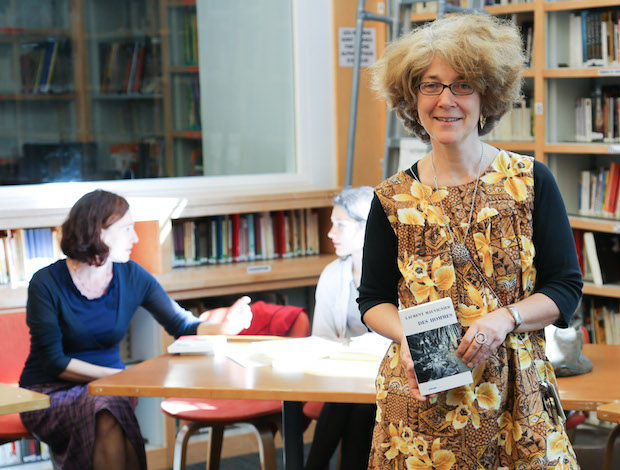
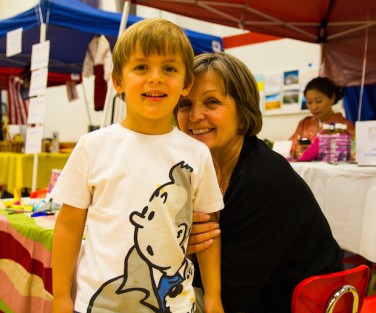
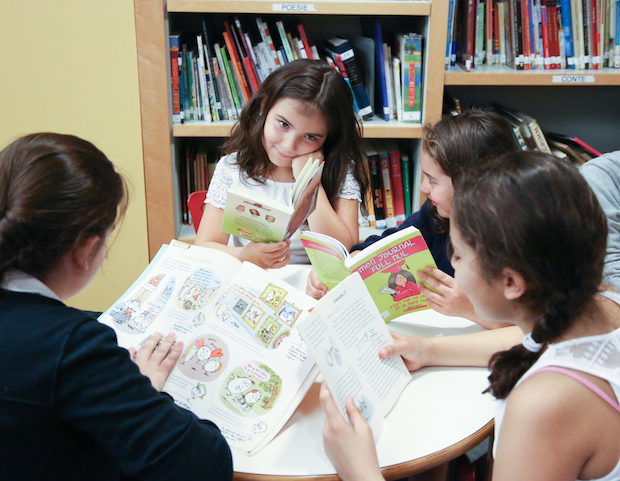
 Bilingual competencies in children change over time
Bilingual competencies in children change over time









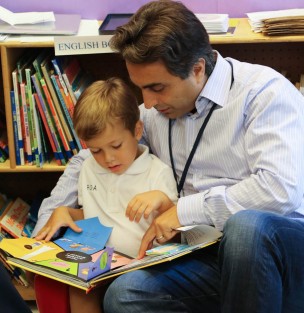
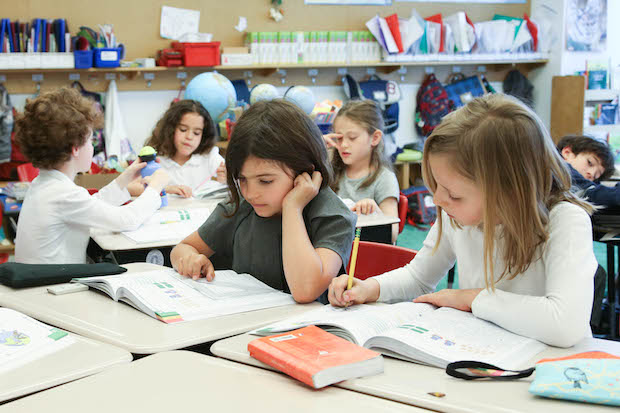


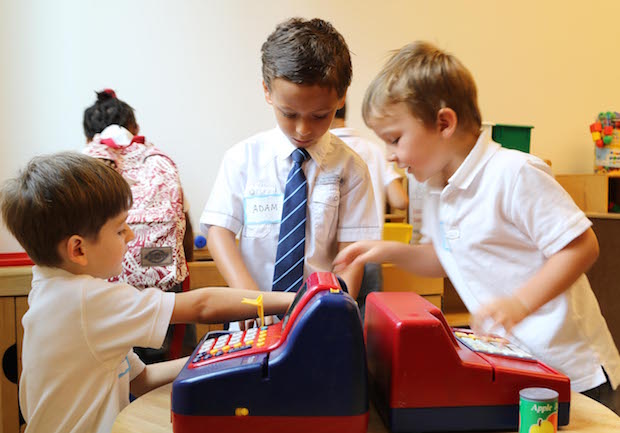

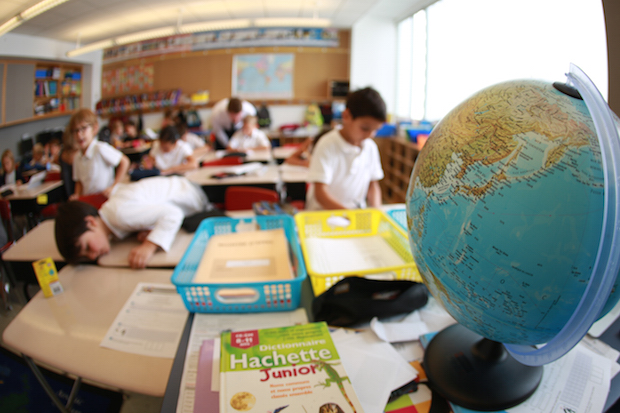

 Mercredi: Parents et administration se rencontrent à l’occasion de la Welcome Fair, organisée par l’association des parents d’élèves du Lycée, l’APL. Les parents en apprennent plus sur les différentes façons de participer à la vie de l’école. Ici, la personne en charge du bénévolat au sein de l’APL, Kiera Faulkner-Jekos, discute avec l’enseignante en anglais et français pour adultes, Anne-Marie Gassier. (photo: E. King)
Mercredi: Parents et administration se rencontrent à l’occasion de la Welcome Fair, organisée par l’association des parents d’élèves du Lycée, l’APL. Les parents en apprennent plus sur les différentes façons de participer à la vie de l’école. Ici, la personne en charge du bénévolat au sein de l’APL, Kiera Faulkner-Jekos, discute avec l’enseignante en anglais et français pour adultes, Anne-Marie Gassier. (photo: E. King)
 Mardi: Justine Guérin et Kristina Gretouce, enseignantes binômes en grande section, présentent le programme et l’organisation de l’année à venir aux parents d’élèves de leur classe à l’occasion des “Curriculum Nights”. Des présentations de la sorte sont organisées à tous les niveaux de l’élémentaire et du secondaire.
Mardi: Justine Guérin et Kristina Gretouce, enseignantes binômes en grande section, présentent le programme et l’organisation de l’année à venir aux parents d’élèves de leur classe à l’occasion des “Curriculum Nights”. Des présentations de la sorte sont organisées à tous les niveaux de l’élémentaire et du secondaire.